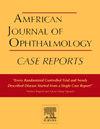Limbal stem cell deficiency secondary to vitrectomy in the context of an autoimmune polyendocrine syndrome type
Q3 Medicine
引用次数: 0
Abstract
Purpose
Autoimmune polyendocrine syndromes (APS) are rare diseases characterized by immunologic activity against multiple endocrine organs. Bilateral keratitis and limbal stem cell deficiency are manifestations described.
Methods
A 28-year-old man presented to our service with discomfort in his left eye. Past medical history included autoimmune polyendocrine syndrome, under hormonal treatment. Ocular history included an idiopathic bilateral peripheral occlusive vascular retinal disease, with areas of non-perfusion, neovascularization, and bleeding, treated with laser photocoagulation. He presented with a vitreous hemorrhage which was treated with a 20-gauge pars plana vitrectomy and endolaser. On review of family history, the patient reported having an older brother also affected by APS, developing the same bilateral retinal affection.
Results
Examination of the anterior segment of the left eye revealed a superior corneal epithelial irregularity. Fundus examination was significant for retinal arteries with segmental blood flow, box-carring, along with peripheral laser scars over previously ischemic areas. Corneal scraping and impression cytology demonstrated goblet cells on the corneal surface epithelium. A diagnosis of limbal stem cell insufficiency was made, and the patient was started on ocular lubricating drops and topical corticosteroids. At follow-up, the patient has been stable.
Conclusions
We describe a case of iatrogenic limbal stem cell insufficiency related to vitrectomy in a patient with autoimmune polyendocrine syndrome, a risk factor for this presentation. We propose that surgical trauma near the limbus and damage to the corneal sub‐basal nerve plexus during vitrectomy may result in the development of limbal stem cell deficiency in a predisposed eye, as postulated in this patient with an APS.
自身免疫性多内分泌综合征型玻璃体切除术后继发的角膜缘干细胞缺乏
目的自身免疫性多内分泌综合征(APS)是一种罕见的疾病,其特征是对多个内分泌器官的免疫活动。描述了双侧角膜炎和角膜缘干细胞缺乏的表现。方法一名28岁男子因左眼不适前来就诊。既往病史包括自身免疫性多内分泌综合征,接受激素治疗。眼部病史包括特发性双侧周围闭塞性血管性视网膜疾病,伴有非灌注、新生血管和出血,用激光光凝治疗。他表现为玻璃体出血,接受了20号玻璃体切割和激光治疗。在回顾家族史时,患者报告有一个哥哥也受到APS的影响,发展出同样的双侧视网膜病变。结果左眼前段检查发现角膜上上皮不规则。眼底检查对视网膜动脉有节段性血流,盒状带,以及先前缺血区域周围的激光疤痕具有重要意义。角膜刮片和印象细胞学检查显示角膜表面上皮有杯状细胞。诊断为角膜缘干细胞功能不全,患者开始使用眼润滑滴剂和局部皮质类固醇。随访时,患者病情稳定。结论:我们报告一例自身免疫性多内分泌综合征患者的医源性角膜缘干细胞功能不全与玻璃体切除术相关,这是导致本病例的危险因素。我们认为,玻璃体切除术期间角膜缘附近的手术创伤和角膜基底下神经丛的损伤可能导致易感眼角膜缘干细胞缺乏的发展,正如本例APS患者所假设的那样。
本文章由计算机程序翻译,如有差异,请以英文原文为准。
求助全文
约1分钟内获得全文
求助全文
来源期刊

American Journal of Ophthalmology Case Reports
Medicine-Ophthalmology
CiteScore
2.40
自引率
0.00%
发文量
513
审稿时长
16 weeks
期刊介绍:
The American Journal of Ophthalmology Case Reports is a peer-reviewed, scientific publication that welcomes the submission of original, previously unpublished case report manuscripts directed to ophthalmologists and visual science specialists. The cases shall be challenging and stimulating but shall also be presented in an educational format to engage the readers as if they are working alongside with the caring clinician scientists to manage the patients. Submissions shall be clear, concise, and well-documented reports. Brief reports and case series submissions on specific themes are also very welcome.
 求助内容:
求助内容: 应助结果提醒方式:
应助结果提醒方式:


